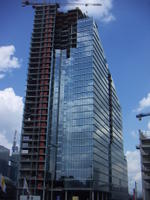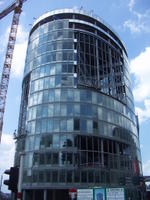
I left work ridiculously early, affording me time to go back home and watch coverage of the London bombings: a terrible Western glimpse into daily life in Baghdad. As always, I'm torn between sadness for the victims and cynicism as to the credibility of declarations by Mssrs. Blair and Bush: denouncements of callousness and disdain for human life are hard to stomach, coming from those two.

The trip back into town was happier than the thoughts above would have you think, even though I was bothered by my ill-advised wolfing down of two bowls of cereal. Going to the Nouveau Marché au Grains takes me further down Antoine Dansaert than usual, well past the Archiduc's art déco stylings and by all the chic, semi-underground designer boutiques. Sure, they're expensive, but the clothes are awesome. The festival's main tent is the bottom edge of a rectangle formed by the World Market's smaller tents. In the middle, there's a basketball court. One can buy food, jewellery and random stuff, or discover Kif Kif radio and their photos of the event.

The line-up and mp3s. My Klinkende Munt photo stream.

Puns as band names are always dubious, and Marockin' Brass, who kicked off the festivities, is no exception. At least the name announces the aim clearly: horns over Moroccan percussion. Interestingly, altoist Cesariusz Gadzina, who released a good saxophone-bass-drums trio album early last year, is part of the band, and provided what was easily the most interesting soloing of all the musicians I've seen so far. It's fairly fun music, but too often the rhythm simply percolates somewhat disconnectedly behind the horns (the key word being behind). This is emphasised when the percussionists take off on their own, turning towards each other, increasing in intensity until finally antique brass instruments (like those long, valveless trumpets used in films set in the Middle Ages) let loose barely-articulate blasts.

Cor de la Plana is a six-man a cappella (apart from a couple of frame drums) vocal group from Marseille that sings Occitan songs. Their subtle and highly sophisticated use of polyphony creates a multi-layered sound in which who is producing what is, at times, dizzingly unclear. The music seems to tap into something ancient, rewriting popular clichés as it brings together reminiscences of both Gregorian and African chanting and rhythms, along with the old Italian and Arabo-Anadalucian influences that have traversed Occitan culture over the centuries. A farandole set off long lines of people dancing, hands joined, the likes of which hasn't been seen since, well, the Middle Ages. It's amazing the energy you can generate just sitting in a semi-circle, clapping your hands and stomping your feet.
 The action shifted to the Beursschouwburg's main building, a short walk back up Antoine Dansaert, for La Panika, a Bulgarian orchestra that plays the kind of Balkanic music made popular by Emir Kusturica's films. An incredible, festive explosion of more-faster saxophone/trumpet/clarinet/accordeon solos (a milder form of free-jazz glossolalia?) and wedding melodies over a solid four-man heavy brass section (I've seen three sousaphone players in two days, a decidedly odd occurrence. La Panika's elephant sousaphone was impressive, though) that even included a Wagner tuba and a snare 'n' bass drum team. The relentless tempos were broken up by the occasional (and very successful) dirge, as well as a young dancer in red. The crowd, needless to say, loved it, especially as a few Bulgarians turned up to lead the Belgian masses.
The action shifted to the Beursschouwburg's main building, a short walk back up Antoine Dansaert, for La Panika, a Bulgarian orchestra that plays the kind of Balkanic music made popular by Emir Kusturica's films. An incredible, festive explosion of more-faster saxophone/trumpet/clarinet/accordeon solos (a milder form of free-jazz glossolalia?) and wedding melodies over a solid four-man heavy brass section (I've seen three sousaphone players in two days, a decidedly odd occurrence. La Panika's elephant sousaphone was impressive, though) that even included a Wagner tuba and a snare 'n' bass drum team. The relentless tempos were broken up by the occasional (and very successful) dirge, as well as a young dancer in red. The crowd, needless to say, loved it, especially as a few Bulgarians turned up to lead the Belgian masses.
The festival is organised by the Beursschouwburg's idiosyncraticly-dressed director, and I've never seen someone take on so many roles at once: announcing bands, directing traffic, mingling with the audience, filming a concert and even serving beer to the musicians on stage.

I had to leave a bit before the end of La Panika's concert, therefore missing Brad Shepik's organ trio... Despite another disappointment (after missing Soulive yesterday) I'm still determined to see Ori Kaplan's Balkan Beatbox tonight, despite a prior restaurant engagement earlier in the evening. And saturday's line-up looks promising, too, as well as edgier. And then there's Brosella on sunday. And then the work week starts again.























 The action shifted to the Beursschouwburg's main building, a short walk back up Antoine Dansaert, for La Panika, a Bulgarian orchestra that plays the kind of Balkanic music made popular by Emir Kusturica's films. An incredible, festive explosion of more-faster saxophone/trumpet/clarinet/accordeon solos (a milder form of free-jazz glossolalia?) and wedding melodies over a solid four-man heavy brass section (I've seen
The action shifted to the Beursschouwburg's main building, a short walk back up Antoine Dansaert, for La Panika, a Bulgarian orchestra that plays the kind of Balkanic music made popular by Emir Kusturica's films. An incredible, festive explosion of more-faster saxophone/trumpet/clarinet/accordeon solos (a milder form of free-jazz glossolalia?) and wedding melodies over a solid four-man heavy brass section (I've seen 

